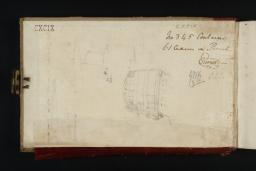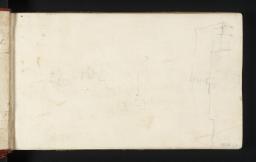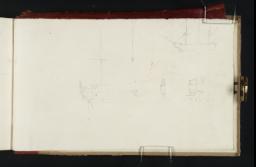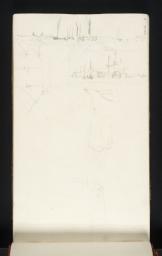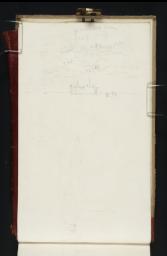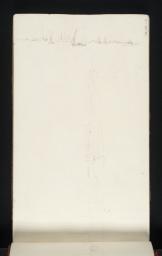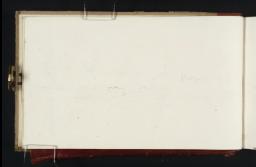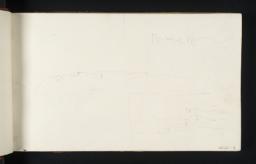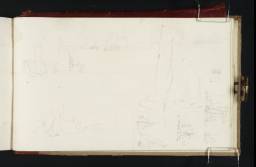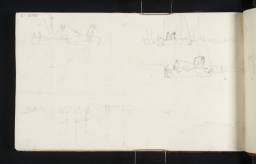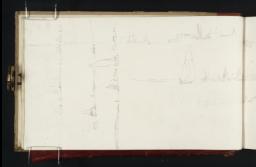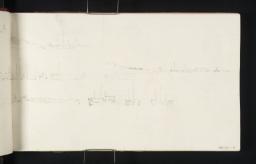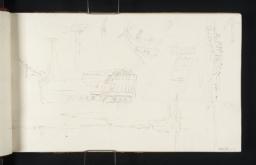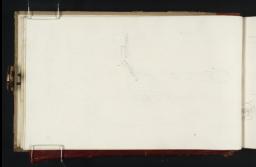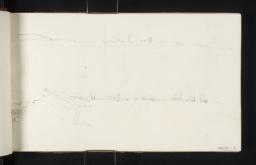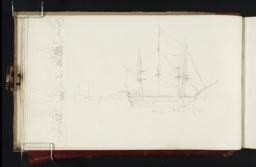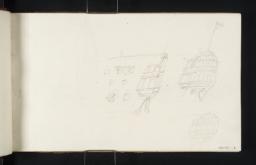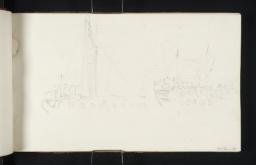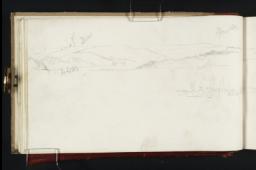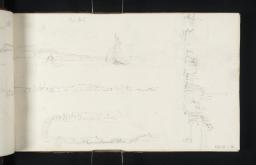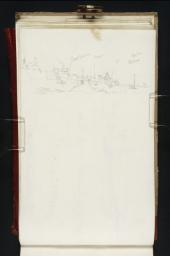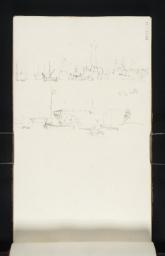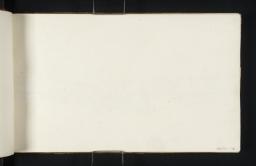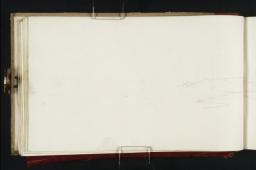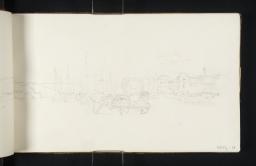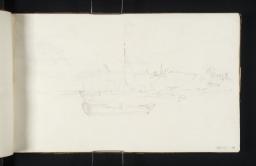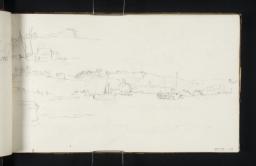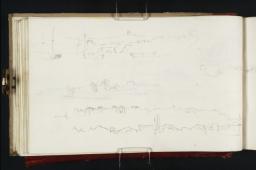Turner Bequest CXCIX 1–90a
Sketchbook, bound in boards, covered in grey paper quarter-bound over brown leather spine; one brass clasp; leather pencil loop along full length of bottom edge of front cover, inset between paper cover and paste-down; page edges washed in yellow
91 leaves and paste-downs of white wove paper; page size 112 x 190 mm
Made by Richard Barnard of Eyehorne Mill or Park Mill, Hollingbourne, Kent; various leaves watermarked ‘R Barnard | 1820’
Numbered 345 as part of the Turner Schedule in 1854 and endorsed by the Executors of the Turner Bequest, inside front cover (D40691)
Inscribed in pencil ‘CXCIX’ on front cover, top right
Stamped in black ‘CXCIX’ on front cover, top right
91 leaves and paste-downs of white wove paper; page size 112 x 190 mm
Made by Richard Barnard of Eyehorne Mill or Park Mill, Hollingbourne, Kent; various leaves watermarked ‘R Barnard | 1820’
Numbered 345 as part of the Turner Schedule in 1854 and endorsed by the Executors of the Turner Bequest, inside front cover (D40691)
Inscribed in pencil ‘CXCIX’ on front cover, top right
Stamped in black ‘CXCIX’ on front cover, top right
Accepted by the nation as part of the Turner Bequest 1856
References
Finberg recognised the dense topographic focus of this book when he assigned its title; the Medway sketchbook, following the wording of Turner’s own label, as noted below.1 Apparently documenting a concentrated investigation of the banks of the Kentish river, this book demonstrates a drive to record detail, both topographic and maritime, with which to inform later compositions. In Andrew Wilton’s words, it ‘contains many tiny pencil notes of the shoreline of Kent seen from a boat out on the water’.2 Various recognisable subjects recur throughout without obvious pattern. Perhaps a broad assessment would find Rochester studies grouped closer to the beginning, with a move towards drawings of shipping around the central pages, and an interest in Chatham and Upnor Castle engaged throughout.
Finberg thought that the sketchbook was in use around 1821.3 He later added that a number of the drawings ‘may have been made in September or October’ of that year.4 Wilton expands Finberg’s assessment by precisely one year, suggesting that Turner explored the Thames and Medway estuaries in September and October of 1822, gathering material for the Rivers and Ports of England series as he went.5 The paper used to fill the sketchbook was manufactured in 1820, as outlined below in the technical notes and demonstrated by the watermarks apparent on various sheets. Finberg’s dating has been retained here in the absence of any clear evidence to the contrary.
Two watercolours were informed directly by studies in this sketchbook. The first of these is Rochester, on the River Medway, of 1822 (Tate D18156; Turner Bequest CCVIII W),6 which was engraved by Thomas Lupton for the Rivers of England series and published in January 1824 (Tate impressions: T06370, T04796–T04798). The relationship between preliminary sketches in this book and the final composition is discussed in the entry for folio 18 recto (D17394). The second painting related clearly to drawings made by Turner within these pages is Castle Upnor, Kent of around 1831 (Whitworth Art Gallery, Manchester)7 engraved by J.B. Allen for the England and Wales series and published in 1833 (Tate impression: T06102). Refer to the entry for folio 87 verso (D17501) for a comprehensive record of the relevant studies of Upnor and associated scholarship.
In addition, Andrew Wilton also suggests that Chatham, from Fort Pitt of about 1830 (private collection),8 engraved in 1832 for the Picturesque Views in England and Wales (Tate impressions: T04588, T04589, T05089), was ‘probably designed with the aid of drawings in the Medway sketchbook’.9 Scenes at Chatham are certainly prevalent, and a comprehensive list of their whereabouts is documented in the entry for folio 22 recto (D17402). Eric Shanes has also identified a colour study related to the same finished design (Tate D25286; Turner Bequest CCLXIII 164).10 In the catalogue entry for that study, Matthew Imms links it to Turner’s drawing of a view of Rochester and the Medway in the Gravesend and Margate sketchbook (Tate D27351; Turner Bequest CCLXXIX 45).
Detailed studies of maritime architecture contribute strongly to the character of this sketchbook. Its pages are peppered with drawings which engage not only with the aesthetic impression of a diverse spectrum of vessels, but also the technical detail which facilitates their function. Anthony Bailey relates this frenzy of technical drawing to a royal commission in progress in 1823.11 He states that, in order to paint an immense picture of The Battle of Trafalgar (National Maritime Museum, Greenwich),12 at that time Turner ‘revisited the Medway and sketched details of warship hulls, spars and rigging’, the fruits of which lie here.13 This view does not quite fit with the slightly earlier dating of the Medway sketchbook as outlined above. However, Turner certainly returned to the drawings in this book in the 1820s and 30s, and the sketches of shipping here may have contributed to his research for the commission, which was actually in place at least as early as the end of 1822, although the painting seems to have been produced largely in 1823–4.14 A composition more directly influenced by the drawings of shipping in this sketchbook is once again Castle Upnor, Kent. The man of war on folio 43 verso (D17438) supplied the basic design for the vessel on the left hand side of the watercolour.15
For additional sketchbooks in which Turner considers the River Medway, see the South Wales sketchbook of 1798 (Tate D00634, D00635, D00638; Turner Bequest XXVI 76, 77, 79); the Hesperides (1) sketchbook of about 1805–7 (Tate D05791; Turner Bequest XCIII 16); the River and Margate sketchbook of around 1805–9 (Tate D06405, D06407, D06425, D06428, D06449–D06450, D06454–D06455, D06459, D06470–D06471; Turner Bequest XCIX 28, 29, 40, 42, 53a, 54, 56a, 57, 59, 64a, 65); the Folkestone sketchbook of 1821–2 grouped here as part of the same section (Tate D17217–D17218, D17221–D17223, D17303–D17304, D17342–D17343, D17345–D17346, D17350; Turner Bequest CXCVIII 6a–7, 8a–9a, 58a–59, 79a–80, 81–81a, 83); and the Gravesend and Margate sketchbook of around 1832 (Tate D27355; Turner Bequest CCLXXIX 47).
For watercolours of the Medway, see Shipping at the Entrance of the Medway of about 1807–19 (Tate N02942); Rochester, on the River Medway of 1822, from the Rivers of England series (Tate D18156; Turner Bequest CCVIII W);16 Stangate Creek, on the River Medway of around 1823–4 (Tate D18134; Turner Bequest CCVIII A)17 and The Medway of around 1824 (Tate D18149; Turner Bequest CCVIII P),18 both produced for The Rivers of England series; Moonlight on the Medway of around 1824 (Tate D25451; Turner Bequest CCLXIII 328); Rochester, Strood and Chatham on the Medway, a ‘colour beginning’ of around 1830 (Tate D25231; Turner Bequest CCLXIII 109); and Chatham, Looking towards Rochester and the Medway, also of about 1830 (Tate D25286; Turner Bequest CCLXIII 164). In addition, see the oil painting The Confluence of the Thames and the Medway exhibited in 1808 (Tate T03874).19
For engravings after Turner which describe views of the Medway, see Tate’s impressions of Rochester, on the River Medway 1824, from the Rivers of England series (T04796–T04798, T06370); Stangate Creek, on the River Medway 1827, also for Rivers (T04817–T04818); Castle Upnor, River Medway of 1832, engraved for the England and Wales series and published in 1833 (T06102); and Rochester, Stroud and Chatham, Medway, Kent of 1838, also for England and Wales (T05104, T06127). The watercolour upon which the latter is based was destroyed by fire in 1955.20
For works in collections further afield than Tate, see The Medway, a combination of wash and pencil on paper, composed in about 1794–7 (National Gallery of Scotland, Edinburgh);21 the oil painting Sheerness and the Isle of Sheppey, with the Junction of the Thames and the Medway, from the Nore (‘The Junction of the Thames and the Medway’) exhibited in 1807 (National Gallery of Art, Washington, DC);22 and the pencil and wash On the Medway of around 1823 (private collection).23
Finberg makes a note of ‘Turner’s label on the back “80. Medway.”’24 He refers to a series of labels affixed to a selection of the sketchbooks during the artist’s lifetime. Speculatively, this was in order to initiate a systematic sequence by which to reference specific themes, tours, and eras within notebooks which were of similar or identical appearance from the outside. Ian Warrell dates this process as beginning during Turner’s time in Italy in 1819–20, shortly before the Medway sketchbook was in use, and notes that it may have continued as a means of organisation at a time when the artist was in high demand and working on numerous projects simultaneously.25 In any case, this label is now missing from the spine.
Eric Shanes, Turner’s Watercolour Explorations 1810–1842, exhibition catalogue, Tate Gallery, London 1997, p.73 no.61.
Martin Butlin and Evelyn Joll, The Paintings of J.M.W. Turner, revised ed., New Haven and London 1984, pp.155–7 no.252, pl.255 (colour).
Technical notes
How to cite
Maud Whatley, ‘Medway Sketchbook c.1821’, sketchbook, January 2016, in David Blayney Brown (ed.), J.M.W. Turner: Sketchbooks, Drawings and Watercolours, Tate Research Publication, February 2017, https://www

